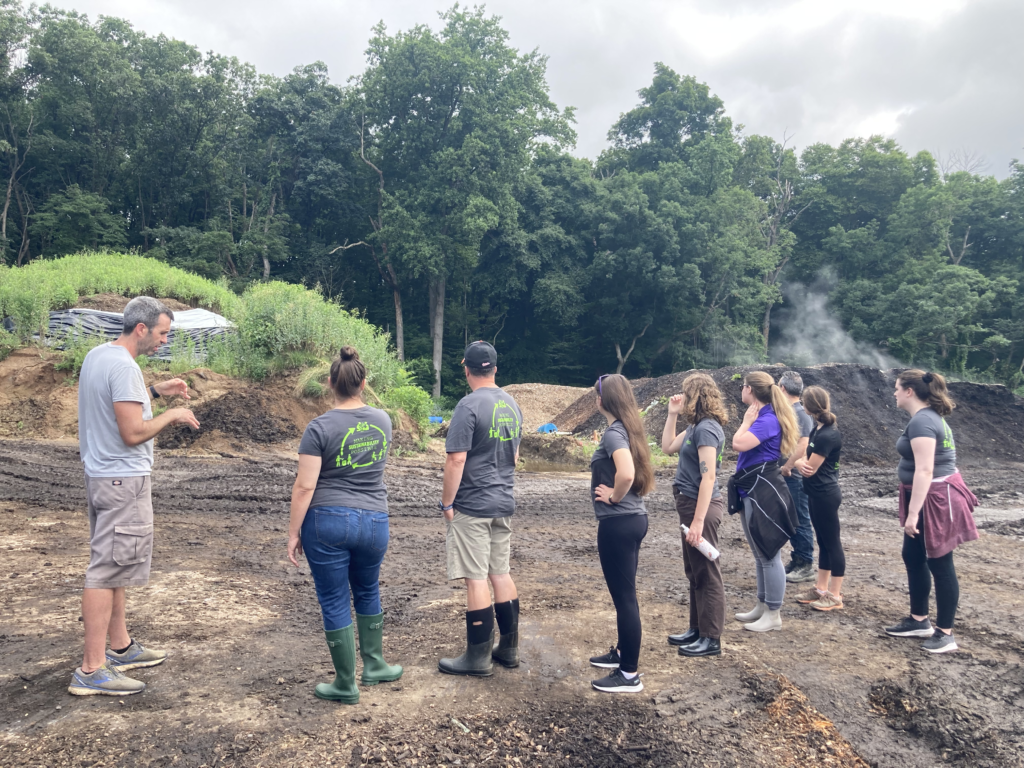Different Composting Methods
(Photo taken on tour at Veteran Compost)
Reduction In Motion has over 20 years of helping companies reduce waste and make sustainability possible. We wrote this blog to help you understand different composting methods for organic waste.
To answer ‘what is compostable’ or ‘what isn’t compostable’, often depends on the composting method used. Some compostable items won’t fully break down into compost within certain composting methods. Learning about the different methods and understanding the advantages and disadvantages that each method has will allow you to compost your organic waste in a more efficient and environmentally friendly way.
Aerobic vs Anaerobic Digestion
The two main types of composting methods use aerobic digestion and anaerobic digestion to break down organic materials into nutrients and minerals for the earth. Aerobic digestion uses a high amount of oxygen and produces heat and CO2. Anaerobic digestion occurs when oxygen is not present, and as a result produces methane, a viable fuel but potent greenhouse gas (GHG).
Aerated Static Pile Composting
Static piles can utilize both kinds of digestion, although aerated static piles are generally more useful and break down food waste much faster. Aerated static piles only take 1-3 months to break down food waste and are able to kill any bacteria or other harmful microbes because it gets so hot; these piles will often reach temperatures of 150 degrees Fahrenheit, and have been known to spontaneously combust.
If the piles aren’t maintained properly, and air is not being infused into the pile at a rate it needs to sustain this process, the pile will turn anaerobic. This will make the pile smell and produce methane as the food is rotting not composting. For this reason, it is hard to maintain large static piles, as it can be difficult to make sure enough air is spread throughout the pile.
Turned Piles / Windrow Composting
This is where turned piles or windrows come into play. These are often scaled up and used by composting facilities to process large amounts of organic matter. These long paths of organic waste are turned by machinery and can have air pumped in them as well to ensure that the pile stays aerobic. Because the piles are turned manually and oxygen levels are often monitored, the result is a high-quality compost product.
In-Vessel Composting
In-vessel composters come in a variety of shapes and sizes. However, they all are generally cylindrical in shape and have the ability to adjust environmental factors that affect the compost, like the temperature, moisture level, odors, and leachate (the liquid that comes from compost piles and is often absorbed into the earth). Because of the precision of control, almost all types of organic waste can be composted using this machinery. However, this type of technology is expensive and as a result it can be hard to find a facility that uses an in-vessel composter near you.
Anaerobic Digestor
Since aeration is a difficult and sometimes energy intensive process, some methods of composting have embraced anaerobic digestion. Anaerobic digesters collect the methane (and other gases that is produced) and use it as biogas. This can be used as a renewable source of natural gas, or processed further to create other types of fuel. The residual leachate and digestate that is left over can also be collected and processed further by an anaerobic digestor. These machines can be expensive and may not be able to handle the same amount of waste as windrow composting can.
Compost Tumblers
All of the above methods of composting, except for the static pile method, is centered around larger composting efforts. However, tumblers are the perfect method of composting for smaller households. Although compost tumblers are relatively small, they are easy to aerate and prevent pests from digging through your pile, as they are typically raised a couple of feet off the ground. Anyone can operate a compost tumbler, so if you are new to composting and looking for a low commitment technique to try, look for the tumbler that is right for you.
Vermicomposting
Vermicomposting is another composting method that is great for breaking down smaller amounts of food scraps. All you need are some red wigglers, a space to house them, and a steady source of material to feed them. Making a house for your worms can be as simple as drilling some homes into 2 plastic bins, as suggested by the EPA.
Bokashi Composting (aka fermented organic matter)
If all of these composting methods sound like too much work for you, the Bokashi method may be best for you. Bokashi composting involves placing your food scraps into an airtight container with some type of an inoculant, or mixture that includes composting microorganisms. This method ferments the food scraps, which produces a product that can be put directly into your garden to complete its decomposition. This method allows you to compost meat and dairy products, and takes the least amount of work to set up and maintain. However, it is important to collect the liquid that is produced from the fermentation process on a regular basis or else the product will begin to smell.

Our team of sustainability and waste consultants work together to develop content for our site. Contact us to learn more about something we’ve written about or would like us to focus on in the future.


